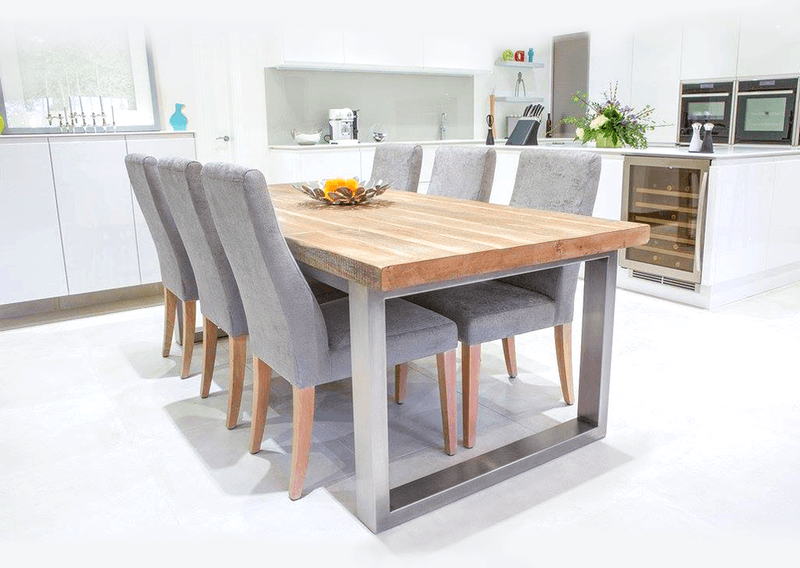About reclaimed wood: Recent years have seen a resurgence in the popularity of reclaimed wood. In essence this is wood that has been used for one purpose in the past (such as being part of a building), which is then ‘reclaimed’ and put to use in another way, for example as part of a new piece of furniture. Its popularity can be put down to many factors: the aesthetics of the furniture it creates, its contribution to environmental sustainability, the interesting histories behind where the wood has been sourced, and the material’s physical characteristics such as its strength, hardiness and looks. Reclaimed wood can be taken from many places: for example, beams and cladding from old barns, warehouses and factories (which is typical of where we source our material).
Why use reclaimed wood?
It’s better for the environment

Today’s world is over-populated and under-resourced. With diminishing natural resources and continued deforestation being two major concerns amongst a plethora of other environmental issues, we should do everything we can to limit our impact on our planet. Using reclaimed wood helps by reducing the need for new timber, but it also lessens our impact on the environment in other ways. Processing reclaimed lumber uses less resources and chemicals, as well as producing less waste material than processing virgin timber.
It is older, stronger, and more durable
It is aesthetically beautiful

The fact that the trees were allowed to mature naturally over hundreds of years has other benefits too, in addition to the strength and durability of the wood already discussed. The rings in reclaimed timber are wider than you see in newer wood and there are also typically more knots and other interesting markings to give the wood its own charm and unique character.
It has a rich and interesting history
Finally, one of the most interesting aspects of reclaimed timber, and the reason it is so highly sought after, is its character. Every beam or plank has its own story which gives a depth and a unique character to the pieces of furniture and structures fashioned from the wood.
Drawbacks
More complicated preparation
There are some things to consider when it comes to reclaimed lumber. In its previous life the wood may have fulfilled many different purposes, whether it be as part of a barn, mill, vessel, cask or other structure, and it must be prepared for its new incarnation!
Reclaimed lumber can often have pieces of metal embedded in it, such as broken off nails. This means a different approach to milling must be taken to avoid ruining blades and saws. Alternatively all metal from can be removed from the reclaimed lumber (the approach we take here at Eat Sleep Live), which is a painstaking and delicate process achieved by manually pulling out all nails, bolt and screws and any other miscellaneous metal fragments.
Ensuring your supplier is providing genuine ‘reclaimed wood’
As furniture and items made from reclaimed wood have risen in popularity, so too have the number of shops and merchants purporting to manufacture and sell items crafted from reclaimed wood. It is key that you ensure you are buying from a reputable organisation - if they are claiming that their wood is reclaimed, press them on the issue and ensure that it really is. Where did they source their lumber? How has it been prepared? If they are selling it, who manufactured it and where? Make sure you’re buying what you’re being told you’re buying.
Eat Sleep Live’s reclaimed wood process
In 2004, when we started Eat Sleep Live, our aim was to provide a high-quality but affordable alternative to the mass-produced, flat-pack furniture that had become so popular in recent years. Our ambition was to provide a bespoke approach to crafting solid reclaimed wood furniture, one which would provide each and every customer with a personal experience and a unique piece of beautiful rustic furniture, for life.
Since then, we’re very proud that we’ve stayed true to our mission while extending our range of handmade wooden furniture.
We source our reclaimed wood from beautiful, historic buildings all over the UK. Some recent examples of the heritage sites we have extracted our wood from include a Victorian manor house in Yorkshire, some old mills and schoolhouses, and an 18th century brewery in Burton on Trent, to name but a few! The average age of our wood is between one and two hundred years.
We hope our guide has given you an understanding of what ‘reclaimed wood’ really is, and why it is not only beautiful, but important too. Feel free to browse our range of solid reclaimed wood furniture, from our Eat, Sleep and Live ranges. If you’d like to see some of our handcrafted pieces, why not call us to arrange a visit to our living showroom, or give us a call if you have any questions. We’d love to hear from you!







